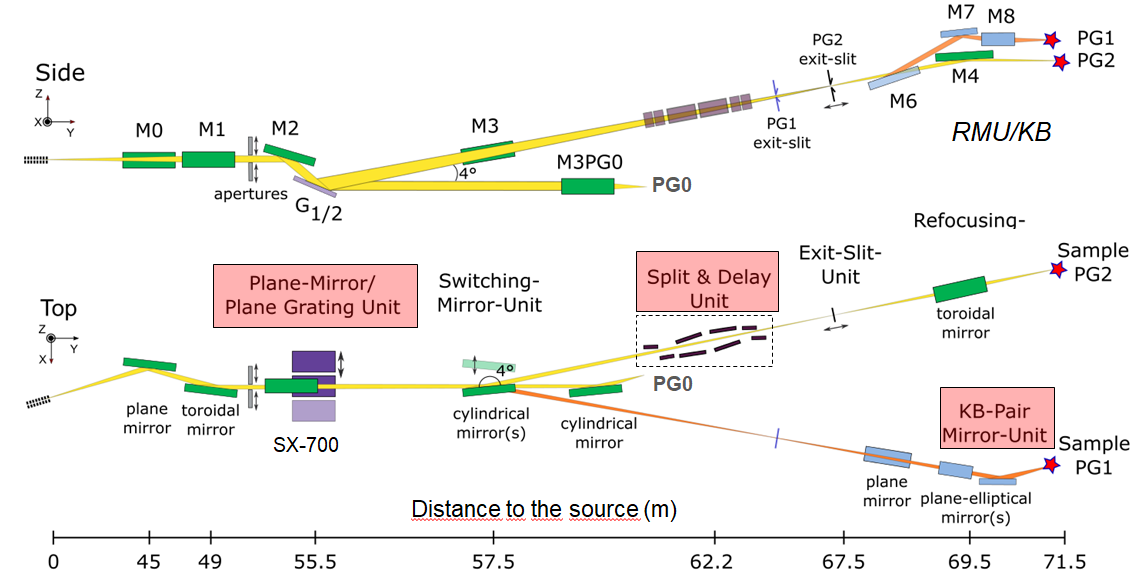The XUV monochromator beamline installed at FLASH is a high-resolution plane grating (PG) monochromator of SX 700 type working over the energy range from 25eV...275eV (FEL fundamental) with an open port for user-provided experimental setups (3m x 4m platform space). The beamline layout permits a free choice of best compromise between photon flux and resolution (<104 bandwidth, DLC coated optics). Furthermore, it can transport the harmonic FEL radiation up to ~900eV with reduced intensity. Typical focus size at the experiment are in the range of 50-100 microns. Besides the monochromatizing operation mode also pink beam operation is possible. A XUV Split- and Delay Unit with variable time delay (±6 ps) for time resolved studies is incorporated in the beamline. Optional pump-probe experiments using the FLASH1 optical laser system synchronized to the x-ray pulses are possible. A high-resolution spectrometer mode (>104 resolving power) allows to characterize the spectral properties of the FEL pulses and the temporal-spectral properties can be controlled at moderate resolution for pump-probe experiments. Standard photon pulse diagnostics and beam manipulation tools like, e.g. GMD intensity monitors, beam position monitors, sets of filters and apertures, gas absorber and a fast shutter are available. Thus, The PG2 monochramator beamline provides enough flexibility over the broad parameter range of FLASH to enable high resolution applications, pump-probe experiments with control over the temporal-spectral properties at moderate resolution, and high photon flux experiments with the option of harmonic filtering.
Split and Delay Unit
- Time-resolved studies
- Time-resolved studies
- X-ray excited optical luminescence (XEOL)
- X-ray fluorescence (XRF)
- Angular Resolved PES
- Photoelectron diffraction
- Spin-resolved ARPES
- Time-resolved studies
- XPS
- Atoms, molecules, clusters and gas-phase chemistry
- Catalysis
- Femtochemistry, solid- and liquid-state chemistry
- Other - Chemistry
- Molecular and cellular biology
- Other - Life Sciences & Biotech
- Other - Material Sciences
- Atomic & molecular physics
- Hard condensed matter - electronic properties
- Hard condensed matter - structures
- High-field science, non-linear X-ray Optics
- Other - Physics
- Quantum electronics & optics
- Surfaces, interfaces and thin films
Building 28c (FLASH1 Hall)
22607 Hamburg
- To control the beamline and the photon diagnostics tools provided by FLASH we have a visualization software called "jddd". This can be used to move screens, motors, etc. and to visualize pulse energy, XUV spectra, ADC traces... and it provides information about the status of the beamline and diagnostics. The underlying FLASH control system is a DESY specific system called "DOOCS". Interfaces for python (and Matlab) are existing to allow read and write access for user scripts to DOOCS controlled parameters.
[http://www.desy.de/~wwwuser/index.html][Link to general information on the FLASH control system and DAQ]
- There are two different approaches possible. The "online" reading of the data stream by python (or Matlab) with the provided API or the "semi online" and offline data analysis using HDF5 files containing user data and all relevant FEL parameters. See FLASH documentation for details.
- HDF5
- A data base for python (and Matlab) scripts is currently build up.
